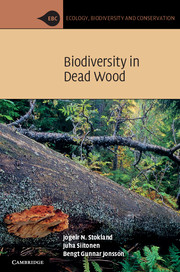Book contents
- Frontmatter
- Contents
- Preface
- 1 Introduction
- 2 Wood decomposition
- 3 The saproxylic food web
- 4 Other associations with dead woody material
- 5 Host-tree associations
- 6 Mortality factors and decay succession
- 7 Microhabitats
- 8 Tree size
- 9 The surrounding environment
- 10 Evolution of saproxylic organisms
- 11 Species diversity of saproxylic organisms
- 12 Natural forest dynamics
- 13 Dead wood and sustainable forest management
- 14 Population dynamics and evolutionary strategies
- 15 Threatened saproxylic species
- 16 Dead wood in agricultural and urban habitats
- 17 The value and future of saproxylic diversity
- References
- Index
4 - Other associations with dead woody material
Published online by Cambridge University Press: 05 June 2012
- Frontmatter
- Contents
- Preface
- 1 Introduction
- 2 Wood decomposition
- 3 The saproxylic food web
- 4 Other associations with dead woody material
- 5 Host-tree associations
- 6 Mortality factors and decay succession
- 7 Microhabitats
- 8 Tree size
- 9 The surrounding environment
- 10 Evolution of saproxylic organisms
- 11 Species diversity of saproxylic organisms
- 12 Natural forest dynamics
- 13 Dead wood and sustainable forest management
- 14 Population dynamics and evolutionary strategies
- 15 Threatened saproxylic species
- 16 Dead wood in agricultural and urban habitats
- 17 The value and future of saproxylic diversity
- References
- Index
Summary
Some of the species associated with snags, logs and hollow living trees do not depend on dead wood as a source of nourishment. Instead, they use cavities and other dead-wood microhabitats for various purposes such as nesting, roosting, denning and hibernation. These species may be obligate saproxylics if the availability of dead wood is essential for their survival during some part of their life cycle. Many facultative saproxylic species use dead wood more opportunistically, without being dependent on it. In this chapter, we describe these uses of dead woody material, concentrating on saproxylic species that do not belong to the saproxylic food web described in Chapter 3.
Vertebrates
Nesting and roosting in cavities
Many forest-dwelling vertebrates utilize holes and cavities in trees. For instance, in Australia, over 300 vertebrate species are known to use cavities (which are generally referred to as hollows in the Australian literature). The list includes 83 mammals (31% of the total terrestrial mammal species in Australia), 114 birds (15%), 79 reptiles (10%) and 27 amphibians (13%) (Gibbons and Lindenmayer, 2002).
- Type
- Chapter
- Information
- Biodiversity in Dead Wood , pp. 58 - 81Publisher: Cambridge University PressPrint publication year: 2012
- 7
- Cited by

